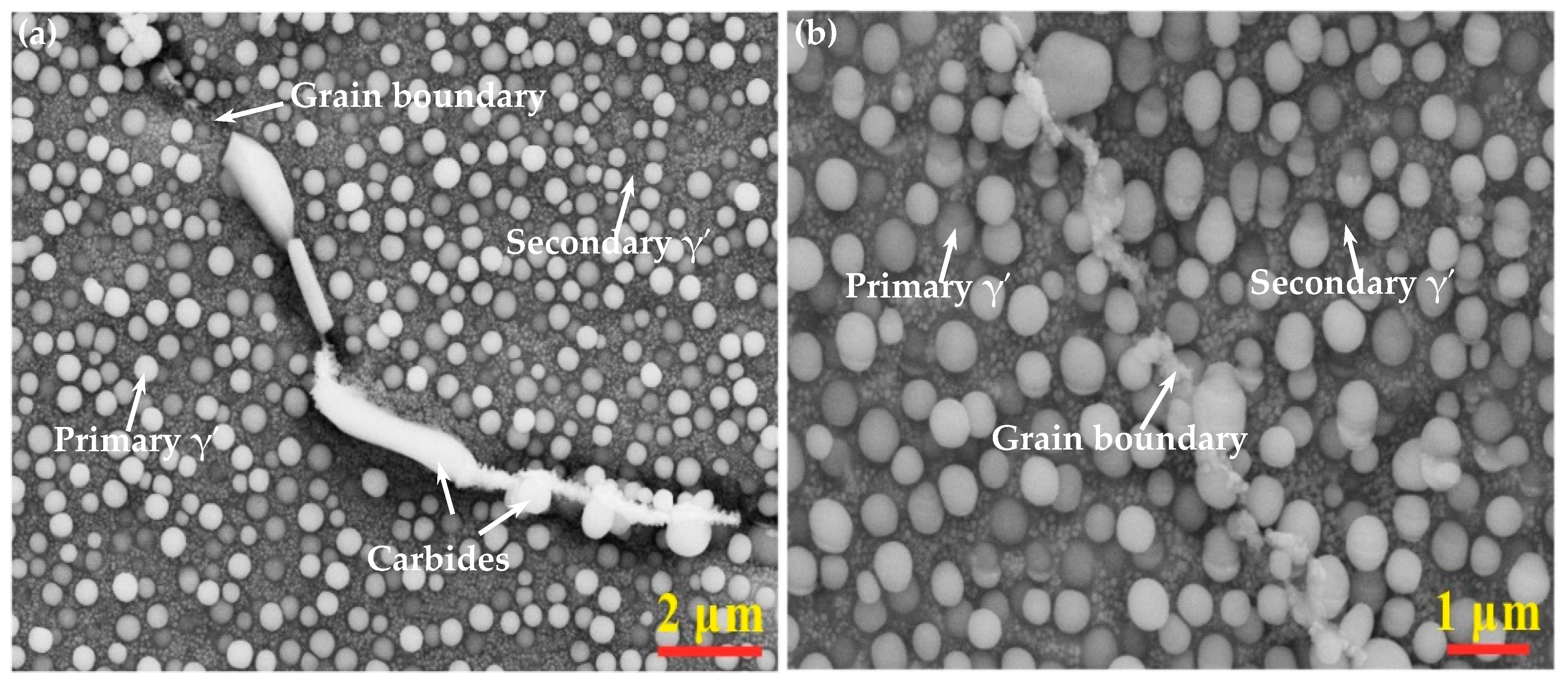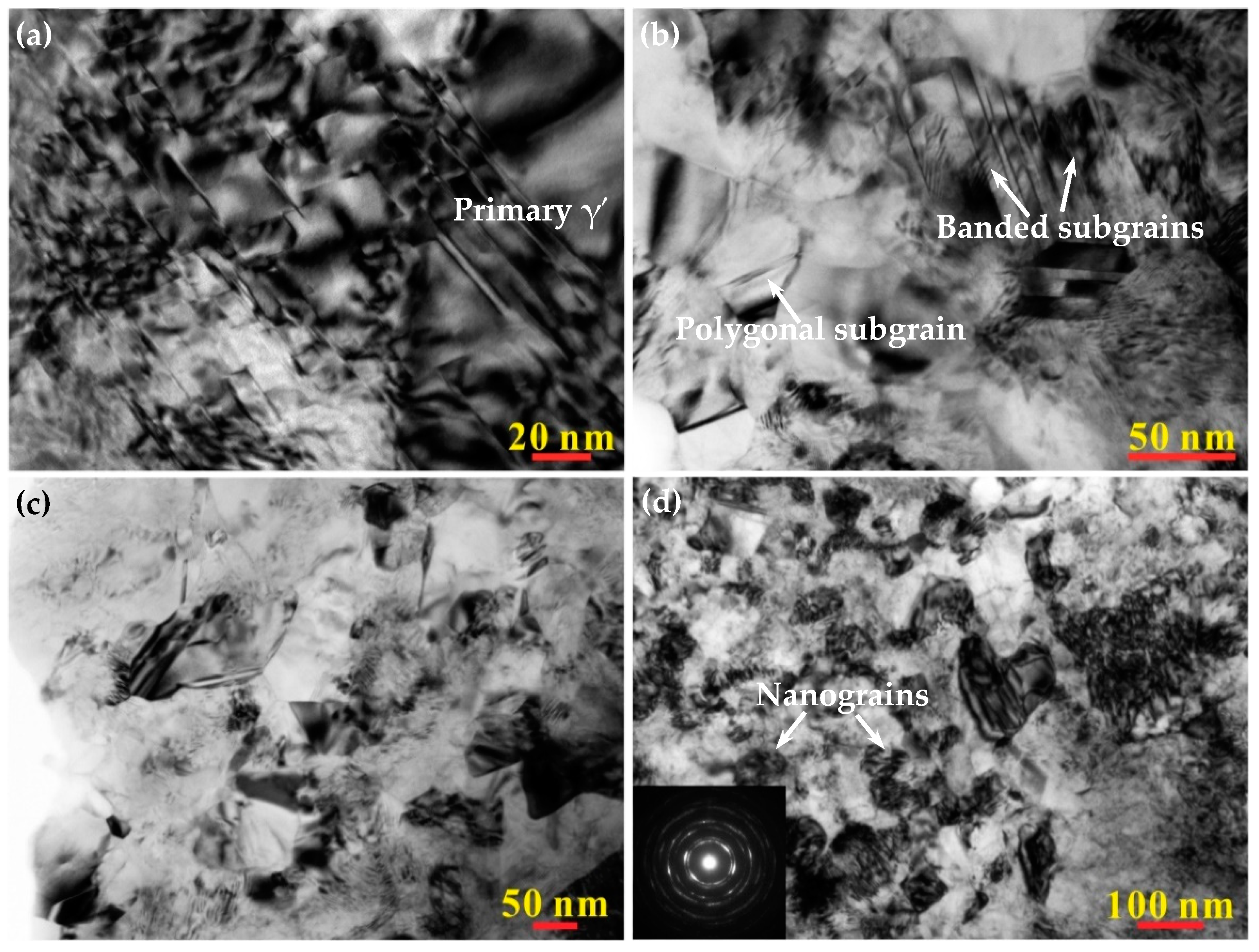Refining Micron-Sized Grains to Nanoscale in Ni-Co Based Superalloy by Quasistatical Compressive Deformation at High Temperature
Abstract
:1. Introduction
2. Experimental
3. Results
4. Discussion
5. Conclusions
- (1)
- The deformation mechanisms of the tested superalloy evolve gradually with the applied compression strain, which in our study was controlled by dislocation slipping and SF shearing at lower strains, transformed into deformation microtwinning at medium strains, and then dominated by SG and NG formation at higher strains.
- (2)
- A nanocrystallization approach is found in an Ni-Co-based superalloy with low SFE via compression deformation at a high temperature and low strain rate, which exhibits obviously differently from the high-SFE alloys that NG formation creates at a low temperature and high strain rate, revealing that the NG formation of the tested superalloy is a thermal activation-assisted process of microstructural evolution.
- (3)
- The NG formation of the tested superalloy can be ascribed to high strain and microtwinning. High strain applied during compression tests produces plentiful dislocations and distorted micro-sized SGs; then, microtwinning resulting from low SFE will refine the micro-sized SGs into NGs with further deformation.
Author Contributions
Funding
Institutional Review Board Statement
Informed Consent Statement
Data Availability Statement
Acknowledgments
Conflicts of Interest
References
- Huang, K.J.; Li, W.; Pan, K.; Lin, X.; Wang, A.H. Microstructure and corrosion properties of La2Zr2O7/NiCoAlY thermal barrier coatings deposited on Inconel 718 superalloy by laser cladding. Coatings 2021, 11, 101–112. [Google Scholar] [CrossRef]
- Antonov, S.; Rozman, K.A.; Jablonski, P.D.; Detrois, M. Implications of carbon content for the processing, stability, and mechanical properties of cast and wrought Ni-based superalloy Nimonic 105. Mater. Sci. Eng. A 2022, 857, 144049. [Google Scholar] [CrossRef]
- Kozlovskiy, A.L.; Zdorovets, M.V. Synthesis, structural, strength and corrosion properties of thin films of the type CuX (X = Bi, Mg, Ni). J. Mater. Sci. Mater. Electron. 2019, 30, 11819–11832. [Google Scholar] [CrossRef]
- Shlimas, D.I.; Kozlovskiy, A.L.; Zdorovets, M.V. Study of the formation effect of the cubic phase of LiTiO2 on the structural, optical, and mechanical properties of Li2±xTi1±xO3 ceramics with different contents of the X component. J. Mater. Sci. Mater. Electron. 2021, 32, 7410–7422. [Google Scholar] [CrossRef]
- Gu, Y.F.; Cui, C.Y.; Yuan, Y.; Zhong, Z.H. Research progress in a high performance cast & wrought superalloy for turbine disc applications. Acta Metall. Sin. 2015, 51, 1191–1206. [Google Scholar]
- Gu, Y.F.; Fukuda, T.; Cui, C.Y.; Harada, H.; Mitsuhashi, A.; Yokokawa, T.; Fujioka, J.; Koizumi, Y.; Kobayashi, T. Comparison of mechanical properties of TMW alloys, new generation of cast-and-wrought superalloys for disk applications. Metall. Mater. Trans. A 2009, 40, 3047–3050. [Google Scholar] [CrossRef]
- Gu, Y.F.; Harada, H.; Cui, C.Y.; Ping, D.H.; Sato, A.; Fujioka, J. New Ni-Co-base disk superalloys with higher strength and creep resistance. Scripta Mater. 2006, 55, 815–818. [Google Scholar] [CrossRef]
- Cui, C.Y.; Gu, Y.F.; Ping, D.H.; Harada, H. Microstructural Evolution and Mechanical Properties of a Ni-Based Superalloy, TMW-4. Metall. Mater. Trans. A 2009, 40, 282–291. [Google Scholar] [CrossRef]
- Luo, Z.P.; Wu, Z.T.; Miller, D.J. The dislocation microstructure of a nickel-base single-crystal superalloy after tensile fracture. Mater. Sci. Eng. A 2003, 354, 358–368. [Google Scholar] [CrossRef]
- Tian, S.G.; Guo, Z.G.; Yu, H.C.; Xue, Y.C.; Zhang, S.; Su, Y.; Meng, F.L. Microstructure evolution and FEM analysis of a [0 1 1] oriented single crystal nickel-based superalloy during compressive creep. J. Alloys Compd. 2013, 563, 135–142. [Google Scholar] [CrossRef]
- Yuan, Y.; Gu, Y.F.; Cui, C.Y.; Osada, T.; Zhong, Z.H.; Tetsui, T.; Yokokawa, T.; Harada, H. Influence of Co content on stacking fault energy in Ni–Co base disk superalloys. J. Mater. Res. 2011, 216, 2833–2837. [Google Scholar] [CrossRef]
- Tian, C.G.; Han, G.M.; Cui, C.Y.; Sun, X.F. Effects of Co content on tensile properties and deformation behaviors of Ni-based disk superalloys at different temperatures. Mater. Des. 2015, 88, 123–131. [Google Scholar] [CrossRef]
- Xu, H.; Zhang, Z.J.; Zhang, P.; Cui, C.Y.; Jin, T.; Zhang, Z.F. The synchronous improvement of strength and plasticity (SISP) in new Ni-Co based disc superalloys by controlling stacking fault energy. Sci. Rep. 2017, 7, 8046. [Google Scholar] [CrossRef] [PubMed] [Green Version]
- Xu, H.; Zhang, Z.J.; Zhang, P.; Cui, C.Y.; Jin, T.; Zhang, Z.F. Formation of nanograins in Ni-Co based superalloys compressed quasistatically at high temperature. Scr. Mater. 2017, 136, 92–96. [Google Scholar] [CrossRef]
- Li, W.; Liu, P.; Ma, F.C.; Rong, Y.H. Microstructural characterization of nanocrystalline nickel produced by surface mechanical attrition treatment. J. Mater. Sci. 2009, 44, 2925–2930. [Google Scholar] [CrossRef]
- Tao, N.R.; Wang, Z.B.; Tong, W.P.; Sui, M.L.; Lu, J.; Lu, K. An investigation of surface nanocrystallization mechanism in Fe induced by surface mechanical attrition treatment. Acta Mater. 2002, 50, 4603–4616. [Google Scholar] [CrossRef]
- Zhao, W.S.; Tao, N.R.; Guo, J.Y.; Lu, Q.H.; Lu, K. High density nano-scale twins in Cu induced by dynamic plastic deformation. Scr. Mater. 2005, 53, 745–749. [Google Scholar] [CrossRef]
- Lu, K.; Lu, J. Surface nanocrystallization of metallic materials-presentation of the concept behind a new approach. J. Mater. Sci. Technol. 1999, 15, 193–197. [Google Scholar]
- Yuan, Y.; Gu, Y.F.; Osada, T.; Zhong, Z.H.; Yokokawa, T.; Harada, H. A new method to strengthen turbine disc superalloys at service temperatures. Scr. Mater. 2012, 66, 884–889. [Google Scholar] [CrossRef]
- Gopinath, K.; Gogia, A.K.; Kamat, S.V.; Balamuralikrishnan, R.; Ramamurty, U. Tensile Properties of Ni-Based Superalloy 720Li: Temperature and Strain Rate Effects. Metall. Mater. Trans. A 2008, 39, 2340–2350. [Google Scholar] [CrossRef]
- Li, Y.; Hong, Z.J.; Liu, B.G.; Jia, X.S. Investigation of microstructure evolution and mechanical properties of multi-precipitation Ni-Co base superalloys. Mater. Sci. Eng. A 2021, 801, 140333. [Google Scholar] [CrossRef]
- Trukhanov, S.V.; Trukhanov, A.V.; Vasiliev, A.N.; Balagurov, A.M.; Szymczak, H. Magnetic state of the structural separated anion-deficient La0.70Sr0.30MnO2.85 manganite. J. Exp. Theor. Phys. 2011, 113, 819–825. [Google Scholar] [CrossRef]
- Kozlovskiy, A.; Egizbek, K.; Zdorovets, M.V.; Ibragimova, M.; Shumskaya, A.; Rogachev, A.A.; Ignatovich, Z.V.; Kadyrzhanov, K. Evaluation of the efficiency of detection and capture of manganese in aqueous solutions of FeCeOx nanocomposites doped with Nb2O5. Sensors 2020, 20, 4851. [Google Scholar] [CrossRef] [PubMed]
- Zhong, Z.H.; Gu, Y.F.; Yuan, Y.; Osada, T.; Cui, C.Y.; Yokokawa, T.; Tetsui, T. Effect of solution temperature on the microstructure and mechanical properties of a newly developed superalloy TMW-4M3. Metall. Mater. Trans. A 2012, 43, 1017–1025. [Google Scholar] [CrossRef]
- Qu, S.; An, X.H.; Yang, H.J.; Huang, C.X.; Yang, G.; Zang, Q.S.; Wang, Z.G.; Wu, S.D.; Zhang, Z.F. Microstructural evolution and mechanical properties of Cu-Al alloys subjected to equal channel angular pressing. Acta Mater. 2009, 57, 1586–1601. [Google Scholar] [CrossRef]
- Hong, C.S.; Tao, N.R.; Huang, X.; Lu, K. Nucleation and thickening of shear bands in nano-scale twin/matrix lamellae of a Cu-Al alloy processed by dynamic plastic deformation. Acta Mater. 2010, 58, 3103–3116. [Google Scholar] [CrossRef]
- Viswanathan, G.B.; Sarosi, P.M.; Henry, M.F.; Whitis, D.D.; Milligan, W.W.; Mills, M.J. Investigation of creep deformation mechanisms at intermediate temperatures in René 88 DT. Acta Mater. 2005, 53, 3041–3057. [Google Scholar] [CrossRef]
- Knowles, D.M.; Chen, Q.Z. Superlattice stacking fault formation and twinning during creep in γ/γ′ single crystal superalloy CMSX-4. Mater. Sci. Eng. A 2003, 340, 88–102. [Google Scholar] [CrossRef]
- Kolbe, M. The high temperature decrease of the critical resolved shear stress in nickel-base superalloys. Mater. Sci. Eng. A 2001, 319–321, 383–387. [Google Scholar] [CrossRef]
- Kovarik, L.; Unocic, R.R.; Li, J.; Sarosi, P.; Shen, C.; Wang, Y.; Mills, M.J. Microtwinning and other shearing mechanisms at intermediate temperatures in Ni-based superalloys. Prog. Mater. Sci. 2009, 54, 839–873. [Google Scholar] [CrossRef]




Disclaimer/Publisher’s Note: The statements, opinions and data contained in all publications are solely those of the individual author(s) and contributor(s) and not of MDPI and/or the editor(s). MDPI and/or the editor(s) disclaim responsibility for any injury to people or property resulting from any ideas, methods, instructions or products referred to in the content. |
© 2023 by the authors. Licensee MDPI, Basel, Switzerland. This article is an open access article distributed under the terms and conditions of the Creative Commons Attribution (CC BY) license (https://creativecommons.org/licenses/by/4.0/).
Share and Cite
Xu, H.; Guo, Y.; Wang, J.; Li, Z.; Wang, L.; Li, X.; Zhang, Z. Refining Micron-Sized Grains to Nanoscale in Ni-Co Based Superalloy by Quasistatical Compressive Deformation at High Temperature. Coatings 2023, 13, 1325. https://doi.org/10.3390/coatings13081325
Xu H, Guo Y, Wang J, Li Z, Wang L, Li X, Zhang Z. Refining Micron-Sized Grains to Nanoscale in Ni-Co Based Superalloy by Quasistatical Compressive Deformation at High Temperature. Coatings. 2023; 13(8):1325. https://doi.org/10.3390/coatings13081325
Chicago/Turabian StyleXu, Hui, Yanjun Guo, Jiangwei Wang, Ze Li, Lu Wang, Xiaohui Li, and Zhefeng Zhang. 2023. "Refining Micron-Sized Grains to Nanoscale in Ni-Co Based Superalloy by Quasistatical Compressive Deformation at High Temperature" Coatings 13, no. 8: 1325. https://doi.org/10.3390/coatings13081325




